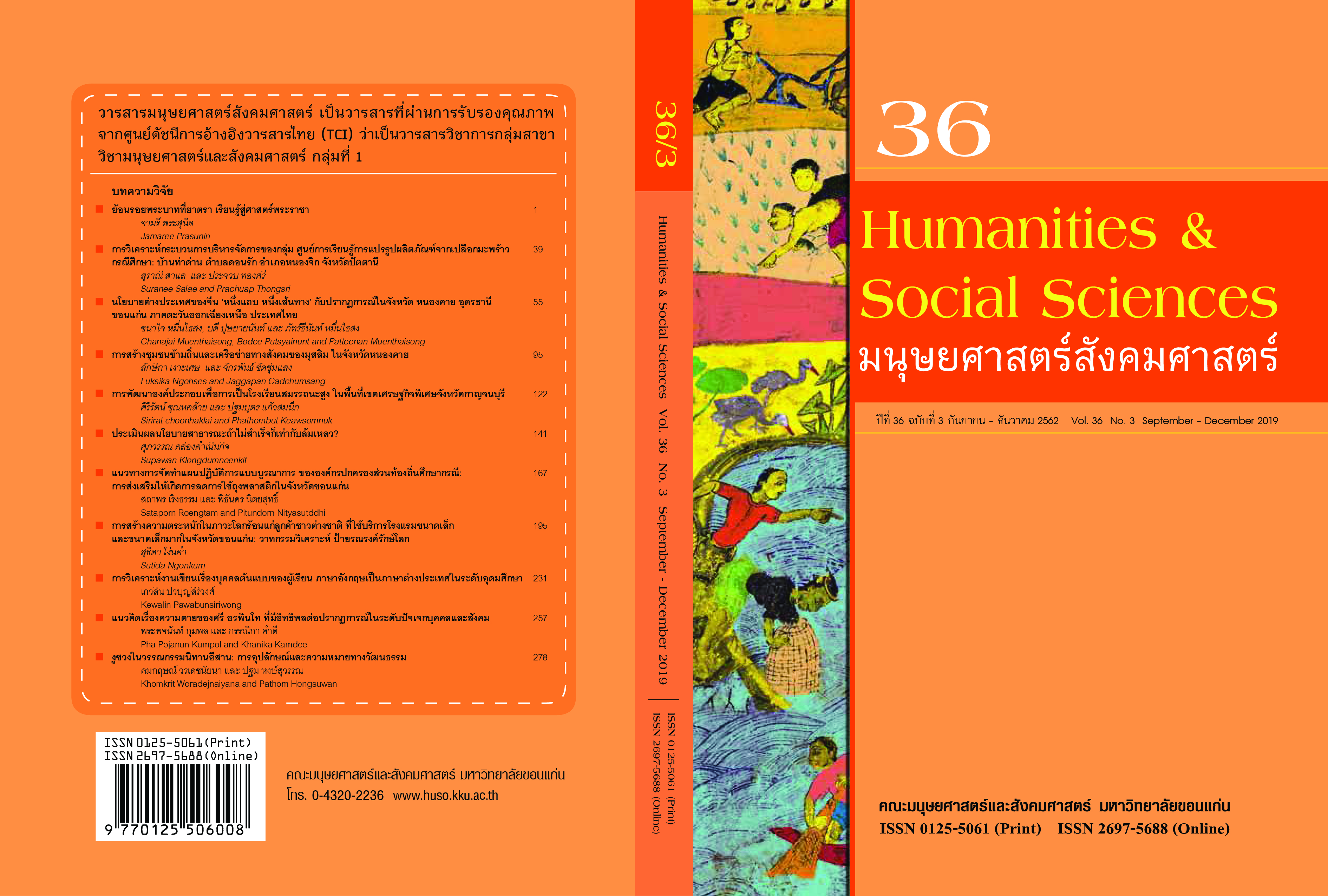งูซวงในวรรณกรรมนิทานอีสาน : การอุปลักษณ์และความหมายทางวัฒนธรรม : Snake in Isan Literature: Metaphors and Cultural Interpretation
Metaphors and Cultural Interpretation.
Keywords:
Snake , Metaphor , Cultural interpreter , Isan literatureAbstract
The purpose of this study is To study snake (Ngusuang) In Isan literature .Metaphor and Cultural interpretation by using animal education concept adapt to considering find the answer of the presented snake in Isan literature metaphor in what the manner is? and How that metaphor has important with cultural interpreter? The study of that metaphor of snake found that 1) Snake is metaphor of raw brutality and dangerous as the result relating from Tan’s creation object to be the medium link between holy world and ordinary world and decrease the power to be the only wild animal which is not cultural product such as pet that human can control and make them tame. 2)Snake is metaphor of the destroy power because The nature has normally power to destroy human who don’t know how to conserve and useful advantage of natural became to reaction of natural to human The cultural issues section has found that 1) The snake is a symbol of natural power. There is a mystery, the intuition, and beyond hum an control. 2) The snake as a symbol of traditional belief, is built from the Tan to eliminate the immoral humans and be reiterated with the images of animals coming from the city of heaven. Paradise City 3) The snake is a symbol of the woman. There is a condition under the dominance. The ride is also linked. They are also linked to nature and are inferior to human beings.
References
ชลธิรา สัตยาวัฒนา. (2561). ด้ำ แถน กำเนิดรัฐไท. กรุงเทพฯ: ทางอีศาน.
ชอบ ดีสวนโคก. (2550). วรรณกรรมพื้นบ้านสินไซ. ขอนแก่น: สำนักการศึกษา เทศบาลนครขอนแก่น.
ดารินทร์ ประดิษฐทัศนีย์. (2559). พินิจปัญหาสิ่งแวดล้อมผ่านมุมมองวรรณกรรมอเมริการ่วมสมัย. กรุงเทพฯ: สำนักพิมพ์จุฬาลงกรณ์มหาวิทยาลัย.
เดวิด คินส์ลีย์. (2551). นิเวศวิทยากับศาสนา. กรุงเทพฯ: แปลนพริ๊นติ้ง.
ธวัช ปุณโณทก. (2525). วรรณกรรมท้องถิ่น. กรุงเทพฯ: โอเดียนสโตร์.
___________. (2542). “งูซวง : สัตว์ในนิยาย” ใน สารานุกรมวัฒนธรรมไทย ภาคอีสาน เล่ม 3. กรุงเทพฯ: มูลนิธิสารานุกรมวัฒนธรรมไทย ธนาคารไทยพาณิชย์
ธัญญา สังขพันธานนท์. (2559). แว่นวรรณคดี ทฤษฎีร่วมสมัย. ปทุมธานี: นาคร.
ธัญญา สังขพันธานนท์. (2560). “ใช่เพียงเดรัจฉาน : สัตวศึกษาในมุมมองของการวิจารณ์เชิงนิเวศ” ใน ทฤษฎีกับการวิจารณ์ศิลปะทัศนะของนักวิชาการไทย. ปทุมธานี: นาคร.
ปฐม หงส์สุวรรณ. (2556). นานมาแล้ว : มีเรื่อง นิทาน ตำนาน ชีวิต. กรุงเทพฯ : สำนักพิมพ์จุฬาลงกรณ์มหาวิทยาลัย.
ปรีชา พิณทอง. (2524). สังข์ศิลป์ชัย. อุบลราชธานี: ศิริธรรม.
ราชบัณฑิตยสถาน. (2545). พจนานุกรมศัพท์วรรณกรรม อังกฤษ-ไทย. กรุงเทพฯ: อรุณการพิมพ์.
วิทย์ ศิวะศริยานนท์. (2544). วรรณคดีและวรรณคดีวิจารณ์. กรุงเทพฯ: ธรรมชาติ.
อัมพร นามเหลา. (2529). ท้าวคัทธนาม. นครราชสีมา: ศูนย์วัฒนธรรมจังหวัดนครราชสีมา วิทยาลัยครูนครราชสีมา.
Garrard, Greg. (2012). Ecocriticism. New York: Routledge.
Lakoff, G. & M. Johnson. (1980). Metaphor We Live By. Chicago: Chicago University Press.


